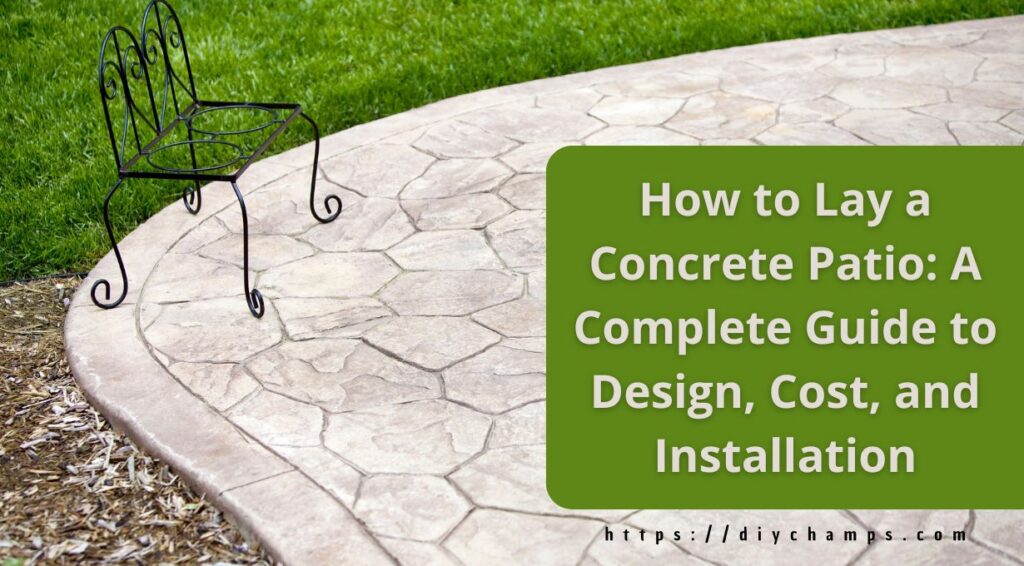A concrete patio is the ultimate backyard upgrade, offering durability, affordability, and endless design possibilities. Whether you want to lay a patio for summer barbecues, create a sleek cement patio with modern finishes like a stamped concrete patio, or explore hybrid designs blending concrete and patio materials, this guide has you covered. Below, we’ll break down every step – from planning and budgeting to advanced techniques like stamped concrete and pressed concrete patio – so you can build a stunning outdoor space that lasts decades.

Part 1: Why Choose a Concrete Patio?
(Benefits of a Concrete Patio)
1.1 Unbeatable Affordability
A concrete patio costs 6–6–15 per square foot, far less than pavers (10–10–30/sq. ft.) or natural stone (20–20–50/sq. ft.). For example, a 300 sq. ft. cement patio costs ~1,800–1,800–4,500 installed, while pavers run 3,000–3,000–9,000.
1.2 Design Flexibility
- Stamped Concrete Patio: Mimics stone, brick, or wood textures for ~12–12–18/sq. ft. (see stamped concrete patio pricing section for details).
- Colored Concrete Patio: Integrate pigments for terra cotta, charcoal, or slate tones.
- Exposed Aggregate: Adds rustic charm with visible pebbles or glass chips.
Pro Tip: Pair a concrete patio with stamped border to save costs while adding visual flair.
1.3 Low Maintenance
- Resists stains, weeds, and pests.
- Requires resealing every 2–3 years (vs. annual paver maintenance).
Part 2: Planning Your Concrete Patio
(Pre-Installation Essentials)
2.1 Design and Layout
- Sketch Your Vision: Use free tools like SketchUp or graph paper to plan size, shape, and patterns.
- Consider Functionality: Will it host a fire pit, outdoor kitchen, or dining area?
- Local Codes and Permits: Check regulations for setbacks, drainage, and patio size (permits often required for 200+ sq. ft.).
2.2 Budgeting and Material Selection
Tools: Rent a mixer ($50/day), trowel, float, and screed board.
Concrete Mix: Opt for 3,500–4,000 PSI mixes for durability.
Reinforcement: Rebar or wire mesh prevents cracks.
Cost Breakdown:
| Item | Cost |
| Concrete Mix | 150 – 200 per cubic yard |
| Gravel Base | 40 – 50 per ton |
| Stamping Mats/Tools | 200 – 500 (rental) |
2.3 Soil and Site Preparation
- Soil Test: Ensure stable, well-draining soil. Clay-heavy soil may require additional gravel.
- Slope: Grade the site with a 1/4-inch slope per foot for drainage.
Part 3: Step-by-Step Installation Guide
(How to Lay a Patio with Concrete)
3.1 Excavation and Base Preparation (Building a Strong Foundation)
- Mark the Area: Use stakes and string to outline the patio.
- Excavate: Dig 6–8 inches deep (12 inches in frost-prone regions).
- Layers of a Patio:
- Sub-base: 4 inches of compacted gravel.
- Sand Layer: 1–2 inches for leveling (optional for pavers).
Common Mistake: Skipping gravel leads to cracks as soil settles.
3.2 Building Forms and Reinforcement (Framing and Stability)
- Wooden Forms: Use 2×4 boards secured with stakes.
- Reinforcement: Lay rebar grids or wire mesh 2 inches above the gravel.
Pro Tip: For a concrete patio with stamped border, install separate forms for the stamped section.
3.3 Pouring and Finishing Concrete (Achieving a Smooth Surface)
- Mix Concrete: Follow the 3:2:1 ratio (cement:sand:aggregate ).
- Pour in Sections: Work in 4×4 ft. areas to avoid drying too quickly.
- Level and Screed: Drag a screed board across the forms.
- Stamp or Texture: For a stamped concrete patio, press molds into the surface within 1–2 hours.
- Cure: Cover with plastic for 7 days; keep moist.
Safety Gear: Gloves, goggles, and knee pads are essential.
Part 4: Paver Patio Installation Overview
(Step-by-Step Laying Pavers)
4.1 Base Preparation
- Excavate: Dig 9–12 inches deep for gravel and sand layers.
- Compact Gravel: Use a plate compactor for stability.
- Sand Layer: Spread 1 inch of sand for leveling.
4.2 Installing Pavers
- Start from a Corner: Use spacers for even gaps.
- Cutting Pavers: Score with a chisel or use a masonry saw.
- Edge Restraints: Secure with spikes or adhesive.
Price to Lay Pavers: ~10–10–20/sq. ft. (labor included).
4.3 Laying Pavers Over Concrete (Refreshing Old Slabs)
- Clean Existing Concrete: Remove debris and grease.
- Apply Adhesive: Use construction adhesive for paver stability.
- Fill Joints: Use polymeric sand to lock pavers in place.
Part 5: Stamped Concrete vs. Pavers
(Which Is Right for You?)
5.1 Cost and Aesthetics
| Feature | Stamped Concrete Patio | Paver Patio |
| Installation Cost | 15 – 30/sq .ft. | 10 – 30/sq. ft. |
| Design Flexibility | High (custom patterns) | Moderate (pre – set shapes) |
| Repairability | Requires Resurfacing | Replace Individual units |
Expert Insight: “Stamped concrete offers high-end looks at half the cost of natural stone.” – John Doe, Landscaping Pro.
5.2 Durability and Maintenance
- Concrete: Resists shifting but may crack in extreme cold.
- Pavers: Shift over time but are easier to repair.
Case Study: A 2023 survey found 60% of homeowners prefer concrete for its longevity.
Part 6: Advanced Techniques and Trends
(Elevate Your Patio Design)
6.1 Stamped Concrete Patio Ideas
- Wood Plank: Ideal for rustic or modern farmhouse styles.
- Cobblestone: Adds old-world charm.
- Geometric Patterns: Create a custom stamped cement patio with hexagons or chevrons.
6.2 Colored Concrete Techniques
- Integral Pigments: Mix dyes into wet concrete.
- Acid Stains: React chemically for marbled effects.
Pro Tip: Pair a colored concrete patio with neutral furniture for a pop of color.
6.3 Hybrid Designs
- Concrete and Patio Combos: Use poured concrete patio for seating areas and pavers for pathways.
- Stamped Borders: Frame pavers with a stamped concrete border for contrast.
Part 7: Maintenance and Repairs
(Protecting Your Investment)
7.1 Cleaning and Sealing
- Annual Pressure Washing: Removes mold and stains.
- Sealing: Use acrylic sealers for stamped concrete patios every 2–3 years.
7.2 Repairing Cracks
- Hairline Cracks: Fill with epoxy or silicone caulk.
- Large Cracks: Resurface with a concrete overlay.
7.3 Winter Care
- Avoid Salt: Use sand or kitty litter for traction.
- Cover Furniture: Protect your cement patio from stains.
Part 8: Environmental Considerations
(Eco-Friendly Practices)
8.1 Permeable Concrete
- Allows water to drain, reducing runoff.
- Costs 10–15% more than standard concrete.
8.2 Recycled Materials
- Use fly ash or recycled glass in your concrete patio mix.
Conclusion
Building a concrete patio is a rewarding project that enhances your home’s value and outdoor living experience. Whether you lay a patio with stamped designs, opt for a classic cement patio, or blend concrete and patio materials for a custom look, this guide equips you with the knowledge to succeed. From budgeting and permits to advanced techniques like stamped cement patio designs, every detail matters. Now, grab your tools, rally your crew, and start creating the backyard oasis you’ve always dreamed of!
FAQs
Q.1: How much does a stamped concrete patio cost?
A: 15–15–30/sq. ft., depending on pattern complexity.
Q.2: Can I DIY a paver patio?
A: Yes! Follow our step-by-step laying pavers guide for best results.
Q.3: How long does a poured concrete patio last?
A: 25–30 years with proper maintenance.
Q.4: Can I install pavers over an existing concrete slab?
A: Yes! Clean the slab, add adhesive, and follow our laying paving over concrete tips.
Q.5: What’s the best way to clean a colored concrete patio?
A: Use a pH-neutral cleaner and avoid harsh chemicals.
